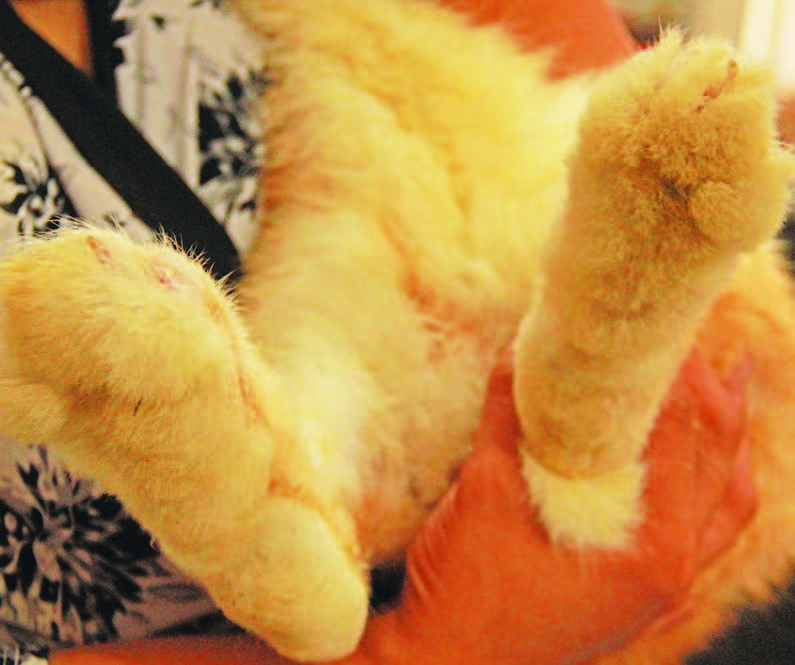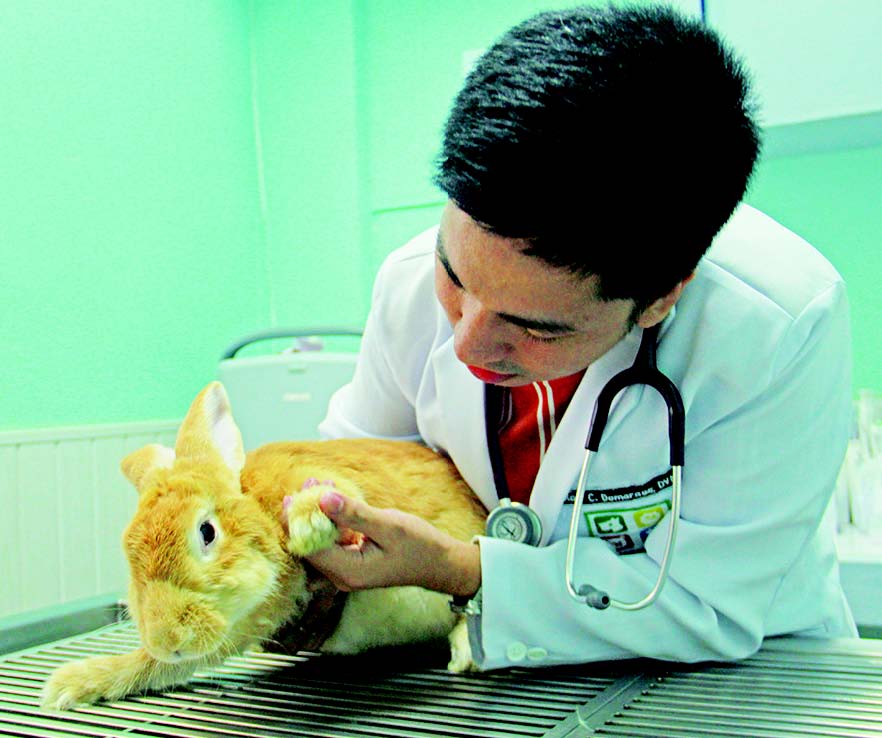Guilty. I’m guilty of housing my rabbits in wire cages with metal floorings. I’m guilty that one of my rabbits suffered from pododermatitis.
Moving forward, it’s important to learn from one’s mistakes. Here are a few things everyone caring for a rabbit should.
Sore hock

Pododermatitis or “sore hock” is a dermatologic condition common in rabbits, characterized by the inflammation of the palmar or plantar region of the forelimbs or, more commonly, the hind limbs.
The severity varies from case to case and is mainly a result of poor husbandry.
Sore feet for rex rabbits

The Rex and Mini Rex have a recessive gene variation that makes their guard hairs rather short. Guard hairs, which are the longer and courser hair on a rabbit’s coat, offer protection to the undercoat, as described by the American Rabbit Breeders Association, Inc.
Different from one species to another
Unlike dogs and cats, rabbits do not have foot pads. Take a look at the undersurface, or the plantar region, of a rabbit’s foot: The skin is covered with fur, but there are no soft pads.

Foot pads provide a protective layer of skin on the undersurface of both hind and forelegs of specific animals, such as dogs and cats.
They are made of keratinized epithelium, which means they are thicker and can cushion the feet, especially in rough terrain.
Wild rabbits, our domestic rabbits’ ancestors, may not necessarily need foot pads – they live in grasslands and forests where the soil and grass buffer their steps.
What causes the problem?
Most rabbit parents buy commercially-available cages, which are commonly made of metal wires. Rabbits are often housed in these because their humans want to protect them from possible predators.
This is where the problem arises.

The wrong flooring material, inadequate bedding, lack of exercise, and poor hygiene – generally what are called poor husbandry practices – usually lead to pododermatitis.
The wire-welded flooring of most cages is not exactly gentle on a rabbit’s feet. An obese rabbit may also be more prone to experience sore hock because of the added pounds their little feet need to support with every hop.
Large breeds, such as Flemish Giants and French Lops, are predisposed to this condition as well due to their heavier bodies. The Rex and Mini Rex are also prone to pododermatitis due to their relatively thinner plantar fur.
‘My rabbit has it’
It was my pet caregiver who fed and cleaned after my pets on a daily basis. One day, I was told that Manjar, my eight-month old Flemish Giant, barely ate.
Of course, I had to find out what was going on right away. The moment I walked into the rabbit room, I knew something was wrong and he was in pain. He barely stood up to greet me and his face showed that he was suffering. I lifted him up and out of his cage and found signs that led to his eventual diagnosis.
Things to watch out for
Symptoms of pododermatitis include the following.
1. Discomfort during sitting or moving about
2. Excessive licking of the feet
3. Lameness
4. Abnormal gait
5. Aggressiveness or any sudden change in temperament when touched
Ulcerative pododermatitis in breeding rabbits

Rabbit in pain
Usually, Manjar would walk and hop around the moment he got out of his cage, but at that time, he just walked a little and lay down in a comfortable position. I checked his underbelly but instead of noticing pain there, I saw an inflamed lesion in the hock area of both hind legs.
I’ve always known about pododermatitis or sore hock, so I was surprised to find out that the rabbit under my care was suffering from it. I thought that just because he wasn’t in his cage 24 hours a day and he had ample time to roam and exercise freely around the house, there was no reason for him to develop pododermatitis.
While I understand how most rabbit parents want to keep their furry friends in cages for hygienic reasons, accessibility, and ease, it just isn’t the right for them.
The lesions on Manjar’s foot weren’t as bad as the others I’ve seen in other animals, but I knew he still needed painkillers. I went to consult a licensed veterinarian right away.
Treating sore hock
Dr. Ros Dumaraos of Hayop Kalinga Animal Clinic said, “Medicines in general can either be poisonous or curative, depending on the dose [and drug being used].” He wanted to remind pet parents not to self-medicate and to always consult with veterinarians first.
He further explained that giving drugs without proper prescription can cause gastric ulcers or enterotoxemia, especially because rabbits have sensitive gastrointestinal tracts (they are hind gut fermenters). This can also cause organ damage. “Instead of making our pets feel better, you can make them feel worse [if you medicate them without medical advice]”, he added.
Manjar wasn’t given systemic antibiotics, but a topical ointment with anti-bacterial and antifungal properties was prescribed. Proper wound care was also recommended.
Dumaraos said, “A simple sore hock can lead to more serious problems, such as inflammation of the synovial membrane in the joint, or inflammation of the bones.”
Doctor’s orders
Since rabbits don’t show pain the same way that other animals do, owners should be extra mindful of them and their habits. Maintain a clean environment, provide balanced diet, and allow big rabbits some regular exercise. Lastly, do not self-medicate.
Prevention better than cure
Fortunately, my other non-giant rabbits didn’t have sore hock. Giant breeds were indeed more predisposed to it, as all the rabbits had their cages at the time and were adopted at around the same time.
I quickly placed floor rags made of cotton inside all the cages to serve as matting. Although cleaning the matting consumed more time, I didn’t want the rabbits’ welfare to be compromised.
More than just flooring
Keep in mind that it’s not just the flooring material one should pay attention to, but also proper nutrition, cage size, and exercise time.
Cliché as it may sound, prevention is definitely better than cure. Veterinary care and medications just won’t do if one doesn’t observe good husbandry practices!
What’s the best flooring?
There are different materials that can serve as bedding or additional flooring. One’s choice depends on the availability of materials and budget.
The British Small Animal Veterinary Association recommends that rabbit cages be fitted with highly durable rubber padding. However, in prolonged periods, pet rabbits can chew and ingest pieces of the rubber matting, causing obstruction in the gut or trachea.
The Royal Society for the Prevention of Cruelty to Animals, on the other hand, recommends the use of bedding that is safe for rabbits to eat and can keep them warm and comfortable. The bottom shelter can be lined with newspaper, followed by a non-cedar wood shaving, then topped with dust-free hay or shredded paper.
This appeared in Animal Scene magazine’s January 2020 issue.
You might want to read:
– Into the rabbit hole: The English Angora rabbit
– Rabbit season: Caring for rabbits as pets
– Seriously cute: The Netherland Dwarf rabbit






